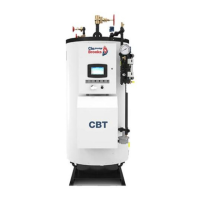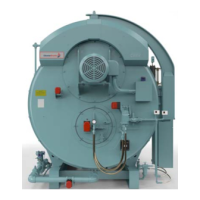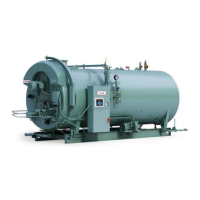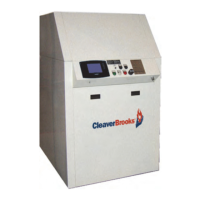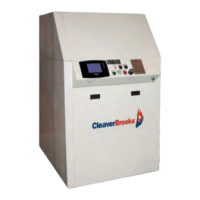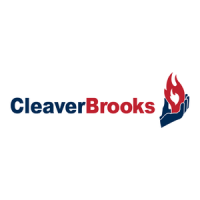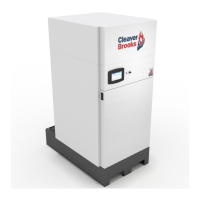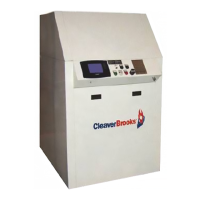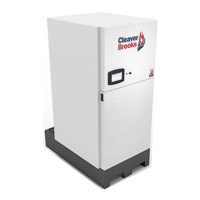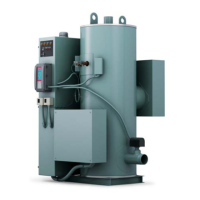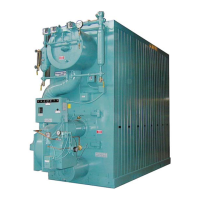750-91 (revised 2009)
Model CB-LE Packaged Boiler Manual
5-5
5.5 — Firing Preparations for No. 2 Oil (Series 100 - 200)
Observe the reading on the air pressure gauge. With no oil flow, the pressure should be a minimum of 7 psi.
If there is no pressure, determine the cause and correct it before proceeding. Check for obstructions in the air inlet
line, incorrect rotation (air pump rotation is clockwise), or a loose oil nozzle or other leaks. If the pressure is much
higher without any oil flow, check for obstruction in the discharge line or at the oil nozzle.
The air pressure will increase when an oil flow exists. At low firing rate, the air pressure may rise to 12 psi or more.
After air flow has been verified, turn the burner switch off and return the run/test switch to the “run” position.
5.5 — Firing Preparations for No. 2 Oil (Series 100 - 200)
Prior to initial firing, oil flow and pressure should be established and verified. Atomizing air pressure should also be
established as outlined in Section 5.4. The schematic flow diagram (see Chapter 2) indicates the flow of fuel and
atomizing air.
If the burner is a combination fuel model, be certain that the main gas shutoff cock is closed and set the gas/oil
selector switch to “oil.” Insert the burner drawer gun into its most forward position and latch it in place.
5.5.1 — Oil Flow
1. Open all valves in the oil suction and oil return lines.
2. If the oil supply tank is located above the level of the pump and flow to the pump is by gravity, then it will usu-
ally be necessary to vent the suction line to allow oil to fill the line. Venting the suction line can generally be
accomplished by cracking a union fitting, or by opening the cap of the oil strainer using care to prevent spillage
of oil. Tighten the fitting or the cap as soon as oil flow appears.
If the oil supply tank is below the level of the oil pump, it is MANDATORY that the suction line to the pump
be completely filled with oil prior to starting the pump to avoid the possibility of damage to the pump gears.
Non-lubricating fluids such as kerosene should not be used for priming.
3. Prior to priming the suction line and the initial start, check to make certain that all plugs, connections, etc., have
been securely tightened to prevent leaks.
4. If the fuel oil supply originates from a pressurized loop, it is assumed that the pressure of the loop will be at a
minimum of 75 psi. Under these conditions, the relief valve at the terminal block should be adjusted to the point
where it becomes inoperative (or removed and openings plugged). To render inoperative, turn the adjusting
screw in as far as possible.
5. A standard equipped boiler has a selector switch incorporated in the oil pump motor starter. Momentarily ener-
gize the starter to check for proper pump rotation. With the rotation verified, operate the pump to determine
that oil circulation exists.
NOTE: The air pressure should not exceed 35 psi at high fire. Greater air pressure causes excessive wear of the air
pump., increases lube oil usage, and can overload the motor, thus causing damage to the equipment.
NOTE: Abnormally high pressure indicated on the nozzle air pressure gauge is an indication that the burner nozzle
has become clogged. In the event of clogging check the nozzle and clean as necessary.
